Moniek Bloks's Blog, page 186
March 17, 2020
Luisa Carlotta of Naples and Sicily – An ambitious Infanta
Luisa Carlotta of Naples and Sicily was born at the Palace of Portici on 24 October 1804 as the daughter of King Francis I of the Two Sicilies and his second wife María Isabella of Spain. She had one surviving half-sister from her father’s first marriage to Maria Clementina of Austria. She had ten full siblings from her father’s second marriage.
She was still only 14 years old when she married her maternal uncle Infante Francisco de Paula of Spain, who was ten years her senior. Her mother was reportedly against the match because she considered her brother to be too reckless. He was the 14th and final child of King Charles IV of Spain and his wife Maria Luisa of Parma. His elder brother became King Ferdinand VII of Spain. The proxy wedding between Francisco and Luisa Carlotta took place on 15 April 1819, and she arrived in Barcelona on 14 May. A second wedding ceremony took place on 9 June 1819 at the Royal Palace of Madrid.
Luisa Carlotta became known for being lively and ambitious. The newlyweds moved into a wing of the Royal Palace of Madrid and between 1820 and 1834, they went on to have 11 children. They were: Francisco de Asís Luis (1820 – 1821), Isabel Fernanda (1821–1897), Francisco de Asís, Duke of Cádiz (1822–1902), Enrique, Duke of Seville (1823–1870), Luisa Teresa (1824–1900), Eduardo Felipe (1826–1830), Josefina Fernanda (1827–1910), María Teresa (1828–1829), Fernando María (1832–1854), María Cristina (1833–1902) and Amalia (1834–1905).
It seemed unlikely that Francisco would ever become King of Spain, he was only fifth in the line of succession. However, his brother Ferdinand VII had no surviving children by first two wives, and he had remarried for a third time just a few months after Francisco married Luisa Carlotta. This third marriage also produced no children, and when his wife Maria Josepha Amalia of Saxony died in 1829, he would remarry for the fourth and final time to Maria Christina of the Two Sicilies, who was also Luisa Carlotta’s younger sister. Luisa Carlotta was reportedly the driving power behind the match. They went on to have two daughters together: the future Queen Isabella II of Spain and Infanta Luisa Fernanda, Duchess of Montpensier. Ferdinand set aside salic law (which barred women from inheriting the throne) in favour of male-preference primogeniture to allow for the succession of his eldest daughter. This law is still in use today in Spain.
Naturally, his brother Carlos – who had been heir to the throne – was none too pleased with this. When his brother died, he issued his own statement declaring his accession to the throne. Maria Christina declared herself regent for her daughter. Luisa Carlotta was also on her niece’s side, but Luisa Carlotta was deeply disappointed her sister’s secret remarriage to Agustín Fernando Muñoz. The Queen regent eventually ordered Luisa Carlotta and her family abroad.
They settled in France where they often attended the court of Louis Philippe, King of French, whose wife Maria Amalia of Naples and Sicily was Luisa Carlotta’s aunt. At the French court, they were described by the Duchess of Dino. “The Infanta is very fair, with a face which, though washed out, is none the less stern, with a rough manner of speaking. I felt very ill at ease with her, although she was very courteous. Her husband is red-haired and ugly, and the whole tribe of little infantes, boys and girls, are utterly detestable.” When Luisa Carlotta’s sister was ousted from her regency and exiled to France, Francisco and Luisa Carlotta were able to return to Spain.
They were eventually allowed to return to Madrid, and they focussed their attention on marrying their sons Francisco de Asis and Enrique to the young Queen Isabella II and her sister Luisa Fernanda. Their insistence led to a second banishment in 1842. In 1843, Queen Isabella was declared to be of age, and Luisa Carlotta and Fransisco returned to Madrid once more. They moved into the Palace of San Juan.
Luisa Carlotta would not see the marriage between her eldest son and the young Queen take place. She died of the measles on 29 January 1844 – she was still only 39. She was buried at El Escorial in the Pantheon of the Princes. On 10 October 1846, the much-desired marriage took place, and her son became King consort of Spain. Through him, she is the ancestress of the current Spanish royal family.
On 19 December 1852, her husband married Teresa de Arredondo y Ramirez de Arellano which was considered to be an unequal or morganatic marriage. Their son was born just one week after their wedding.
The post Luisa Carlotta of Naples and Sicily – An ambitious Infanta appeared first on History of Royal Women.
March 16, 2020
Märtha Louise of Norway – The clairvoyant Princess
Princess Märtha was born on 22 September 1971. Her parents are King Harald V and Queen Sonja of Norway.
Embed from Getty Images
The Princess was born in 1971 while her parents were still Crown Prince and Crown Princess of Norway. Though she was the first-born child, Märtha is not in line to succeed the throne because, at the time of her birth, women were barred from inheriting the throne. In 1990, Norway introduced absolute primogeniture – meaning the eldest child regardless of sex is first in the line of succession. This change only applied to those born after 1990, but Märtha was included in the line of succession behind her younger brother.
Märtha was the first child born to Harald and Sonja and was followed in 1973 by her brother Haakon Magnus who is the current Crown Prince and he will one day become King. At the time of her birth, however, Märtha was in the line of succession for sixteen other countries due to being the great-great-granddaughter of King Edward VII of the United Kingdom.
Embed from Getty Images
Märtha and Haakon were born after their parents had already been together for around a decade before they married, in a true tale of devotion, Harald refused to marry if he was not allowed to marry Sonja who was a commoner or private citizen. Harald’s father Olav V had refused the match for a decade but when it was clear that the family line would die out, he relented, and Harald and Sonja were married in 1968.
Märtha and her brother Haakon were raised relatively out of the public eye and had quite normal childhoods considering their places in the royal family. Märtha had turned twenty by the time her father became King and was focusing on her own education in this period. The Princess studied in Oslo as well as in Maastricht in The Netherlands and qualified as a physiotherapist. Rather than following this career path, however, Märtha has had an eclectic career so far; in storytelling, folk stories, in traditional Norwegian choirs and in spiritual practices. The Princess has also written children’s books and appeared on choir CDs.
In 2002, Princess Märtha poured more energy into her career and took a step back from royal duties, due to this her father decided that her styling of Royal Highness should be removed. Märtha still carries on royal duties, however, and is often known as Highness when overseas.
Embed from Getty Images
Also in 2002, Märtha was married, and like her father, before her, she married a ‘private citizen’, further modernising the Norwegian royal family. Märtha married the author and visual-artist Ari Behn on 24 May 2002. The couple went on to have three daughters in the following years; Maud, Leah and Emma. The family moved around a lot and lived in London, New York and Lommedalen valley near Oslo.
Embed from Getty Images
In 2016, the Royal Court announced that Märtha and Ari were due to divorce and this was finalised in 2017, though the pair remained on good terms and planned to share the custody of their three daughters. Märtha threw herself more into her career after the split and focused more on holistic therapies and her alternative therapy centre known as Astarte Education or Angel school.
Over the years, Märtha has been involved in controversy over Angel school as many people claimed she was using her royal title to promote the centre and to bolster her image as a clairvoyant. Märtha has continuously claimed to be able to communicate with animals and angels. This all went too far for the public in 2014 when Märtha invited psychic and medium Lisa Williams to give a seminar at Angel school (also known as Soulspring). Williams talked about communicating with the dead in her talk which is highly frowned upon in Norway’s Lutheran faith, Märtha had to respond to this in the press by stating that Angel school did not carry out these practices.
On Christmas Day 2019, the Princess and her family were struck by grief as Ari Behn died by suicide following a long period of depression. The whole royal family attended his funeral along with the couple’s children who left floral tributes and drawings for their father. Following the death of her former husband, Princess Märtha is currently living in California in the United States, concentrating on raising her daughters and on her spiritual teachings. Märtha has recently stopped using the title Princess when promoting her business ventures after receiving criticism over this.
The Princess has recently found happiness with her new boyfriend Durek Verrett, who shares Märtha’s interests in all things spiritual. Durek is known as Shaman Durek and is a 6th generation shaman, and he is a well-known healer and spiritual guide. Shaman Durek has a high-profile celebrity client base including Gwyneth Paltrow who has become friends with Princess Märtha recently.
Embed from Getty Images
Märtha seems besotted with her new lover and has shared many images of them together on her Instagram account, calling Durek her ‘twin flame’. Of course, Märtha expected ridicule and criticism from the press over her new relationship and when people started to call Shaman Durek a fraud and a con artist she responded by telling people to ‘hold your horses’ and went on to state that she did not choose her man to satisfy anyone else and that it is not up to anyone else to judge her!
The post Märtha Louise of Norway – The clairvoyant Princess appeared first on History of Royal Women.
March 15, 2020
Victoria Kinoiki Kekaulike – Mother of the three Princes
Victoria Kinoiki Kekaulike was born on 12 May 1843 as the youngest daughter of High Chief Kūhiō Kalanianaʻole of Hilo and Princess Kinoiki Kekaulike. Her elder sisters were Queen Kapiolani of Hawaii and Virginia Kapoʻoloku Poʻomaikelani.
On 25 February 1861, Kekaulike married High Chief David Kahalepouli Piʻikoi. They went on to have three sons together: David Kahalepouli Kawānanakoa (born 19 February 1868), Edward Abnel Keliʻiahonui (born 13 May 1869) and Jonah Kūhiō Kalanianaʻole (born 26 March 1871). When her sister’s husband became King of Hawaii in 1874, Kekaulike was granted the title of Princess with the style of Her Royal Highness. Her sons were made Princes with the style of His Royal Highness. She played a role in her brother-in-law’s coronation ceremony, and she carried the royal feather cape, which she handed to Chief Justice Albert Francis Judd who then places it on her brother-in-law’s shoulders.
Kekaulike was widowed on 18 October 1878. Kekaulike also served as Governor of Hawaii Island from 1880 until her death in 1884, succeeding Princess Miriam Likelike. Kekaulike fell ill a year after the coronation with what was believed to be a heart disease. She died on 8 January 1884 at her residence in Honolulu – still only 40 years old. She was interred in the Royal Mausoleum of Hawaii. Two of her sons were adopted by her sister the Queen, while her middle son was adopted by her sister Poomaikelani. The three princes were sent to a military school in California a year after her funeral.
The post Victoria Kinoiki Kekaulike – Mother of the three Princes appeared first on History of Royal Women.
March 14, 2020
The seven Princesses Royal
The title of Princess Royal is usually granted by the British monarch to their eldest daughter. It was Henrietta Maria of France, consort of King Charles I, who wanted to have a title similar to the “Madame Royale” title in France. It was their daughter Mary, who became the first Princess Royal in 1642. However, the French Madame Royale was often used for the eldest unmarried daughter and could pass to the next daughter when the elder married. The British Princess Royal title is for life and can only be granted again when the holder dies.
So far, there have been seven Princesses Royal.
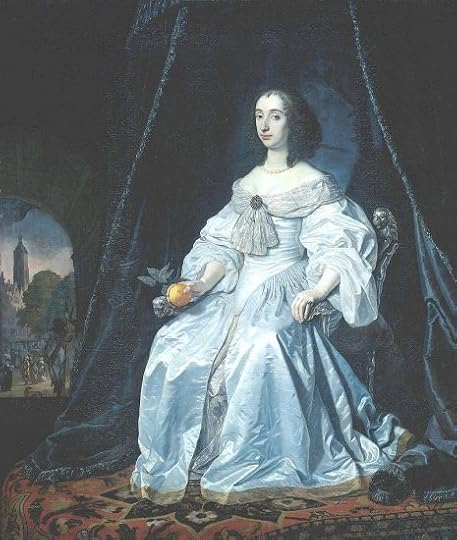 (public domain)
(public domain)Mary, Princess Royal and Princess of Orange
Mary was the daughter of King Charles I and Henrietta Maria of France, and she was also the first bearer of the title, ‘Princess Royal’. Mary was born on 4 November 1631 at St. James’s Palace as the eldest of nine children. On 2 May 1641, she married the future William II, Prince of Orange and together they had one son – the future King William III of England. In 1642, she was created Princess Royal, and she held the title until her death in 1660.
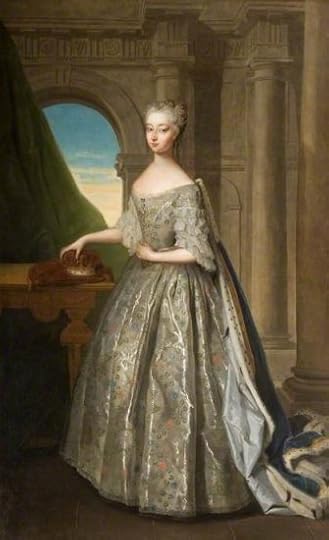 Anne, Princess Royal and Princess of Orange (public domain)
Anne, Princess Royal and Princess of Orange (public domain)Anne, Princess Royal and Princess of Orange
Anne was born on 2 November 1709 as the daughter of King George II of Great Britain and Caroline of Ansbach. On 30 August 1727, George II created his eldest daughter Princess Royal as the title had remained unused since 1660. In 1734, Anne married William IV, Prince of Orange. They had a happy marriage, but Anne suffered several miscarriages before giving birth to a daughter named Carolina and a son and heir, the future William V. She died on 12 January 1759.
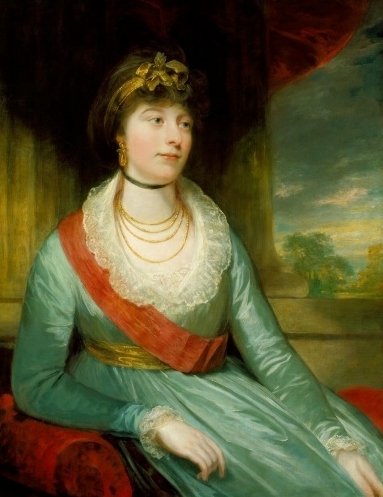 Charlotte, Princess Royal (public domain)
Charlotte, Princess Royal (public domain)Charlotte, Princess Royal and Queen of Württemberg
Charlotte was born on 29 September 1766 as the daughter of King George III of the United Kingdom and Charlotte of Mecklenburg-Strelitz. On 22 June 1789, she was created Princess Royal by her father. On 18 May 1797, she married Frederick, Hereditary Prince of Württemberg and subsequently became Hereditary Princess, Duchess, Electress and finally Queen of Württemberg. They had one child together – a stillborn daughter. She died on 6 October 1828.
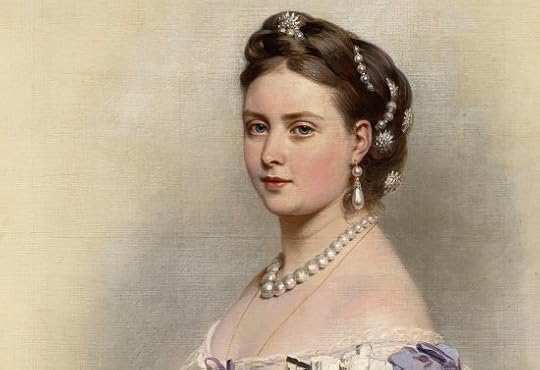 Victoria, Princess Royal and German Empress (public domain)
Victoria, Princess Royal and German Empress (public domain)Victoria, Princess Royal and German Empress
Victoria was born on 21 November 1840 as the daughter of Queen Victoria of the United Kingdom and Prince Albert. On 19 January 1841, she was created Princess Royal by her mother. On 25 January 1858, she married the future Frederick III, German Emperor, whose reign would be tragically short. They went on to have eight children together, though two would die in childhood. She died on 5 August 1901.
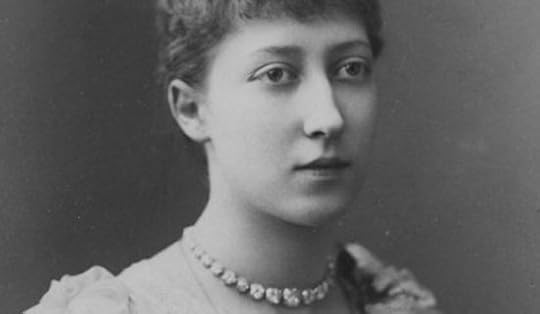 Louise, Princess Royal and Duchess of Fife (public domain)
Louise, Princess Royal and Duchess of Fife (public domain)Louise, Princess Royal and Duchess of Fife
Louise was born on 20 February 1867 as the daughter of King Edward VII and Alexandra of Denmark. On 27 July 1889, she married Alexander Duff, 1st Duke of Fife and they had three children together, though their only son was stillborn. On 9 November 1905, she was created Princess Royal by her father. She died on 4 January 1931.
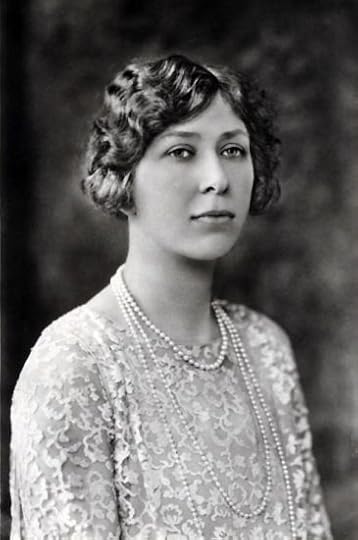 Mary, Princess Royal and Countess of Harewood (public domain)
Mary, Princess Royal and Countess of Harewood (public domain)Mary, Princess Royal and Countess of Harewood
Mary was born on 25 April 1897 as the daughter of King George V and Mary of Teck. On 28 February 1922, she married Viscount Lascelles, later Earl of Harewood and they went on to have two sons together. On 1 January 1932, just short of one year following the death of the previous Princess Royal, she was created Princess Royal by her father. She died on 28 March 1965. As she was alive during the entire reign of King George VI, the future Queen Elizabeth II could not be created Princess Royal.
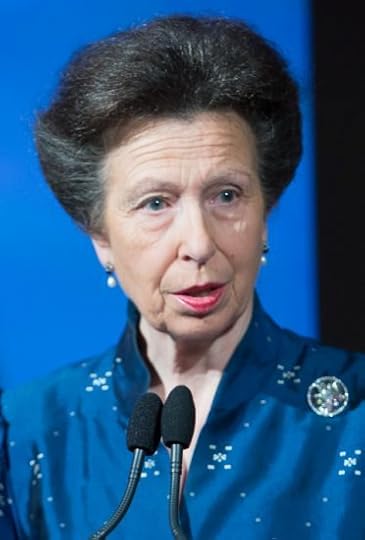 Anne Princess Royal (By Chatham House – CC BY 2.0 via Wikimedia Commons)
Anne Princess Royal (By Chatham House – CC BY 2.0 via Wikimedia Commons)Anne, Princess Royal
The current holder of the title is Anne, the eldest daughter of Queen Elizabeth II and Prince Philip, Duke of Edinburgh. She was born on 5 August 1950. On 14 November 1973, she married Mark Phillips, and they went on to have a son and a daughter together. They eventually divorced on 23 April 1992. On 12 December 1992, she remarried to Timothy Laurence. Anne undertakes royal duties on behalf of her mother.
Princess Charlotte?
The next possible holder of the Princess Royal title would be the daughter of the Duke and Duchess of Cambridge, Princess Charlotte. As said before, she could only be granted the title once her father becomes King, and the previous holder has died.
The post The seven Princesses Royal appeared first on History of Royal Women.
March 13, 2020
The Grave of Mary Tudor at St Mary’s Church, Bury St Edmunds
Mary Tudor was born on 18 March 1496 as the daughter of King Henry VII and Elizabeth of York at Sheen Palace, later known as Richmond Palace.
In 1514, she was married off to the much older King Louis XII of France. Mary had little time to consider her life with this ageing King, and her proxy marriage took place on 13 August 1514. However, she made her brother swear that if and when Louis died, she would be free to choose her next husband. By then, she was most likely already in love with Charles Brandon. She left Dover on 2 October 1514 and headed for France. Her tenure as Queen of France would be short as her husband died on 1 January 1515.
Henry sent Charles to negotiate Mary’s return to England. Soon rumours began to circulate that he was there to marry the widowed Queen. Whatever the true purpose, Mary convinced Charles to marry her around the end of February. Henry was furious that Charles acted without his permission and both Mary and Charles wrote letters to Henry begging for his forgiveness.
The couple finally arrived in Dover on 2 May. Henry would make them pay dearly, but fortunately for them, it would not be with Charles’s life. On 13 May 1515, the couple married again in the Church of the Observant Friars in Greenwich. They were now back in favour at court and took up residence in Suffolk Place.
Mary became stepmother to Charles’s daughters Anne and Mary from his marriage to Anne Browne, who had died in 1511. Mary fell pregnant quite quickly and gave birth to a son named Henry on 11 March 1516. A daughter named Frances was born on 16 July 1517, followed by another daughter named Eleanor in 1519 and a son, named Henry after his elder brother who had died in 1522, in 1523. This Henry too would not live to adulthood.
Around 1519, Mary began to suffer from the first bouts of ill health, but she was well enough to attend to Field of Cloth of Gold. After this, her appearances at court would become more sporadic. The couple continued to have money problems throughout their marriage. Charles had also taken a mistress who gave birth to his illegitimate son in 1521. It was yet another blow.
By 1526, it had become clear that Mary’s brother Henry was infatuated with Anne Boleyn. On 23 May 1527, Mary attended her last official engagement at court and watched her brother dance with Anne Boleyn. She withdrew from court, disgusted with her brother’s behaviour.
By the time of Henry’s marriage to Anne Boleyn, Mary had been unwell for several months. Mary just about managed to travel to London for her daughter’s marriage to Henry Grey, Marquis of Dorset and it would be the last time she would see her brother. She returned home with her younger daughter Eleanor and took to her bed. She was invited to Anne Boleyn’s coronation but was most likely too ill to travel.
Mary died on 25 June 1533, and she was still only 38 years old. The true cause of her illness was never diagnosed. She was buried on 20 July in the abbey at Bury St Edmunds with her daughter Frances acting as chief mourner. When the abbey was dissolved in 1539, she was moved to the nearby St Mary’s Church, where she still rests today.
Click to view slideshow.
Entrance to the church is free, though donations are appreciated. I was the only visitor and I was enthusiastically greeted. I was immediately told all about Mary Tudor’s grave and told to go and explore, which was lovely. Do not miss this gem if you are ever in the area.
The post The Grave of Mary Tudor at St Mary’s Church, Bury St Edmunds appeared first on History of Royal Women.
March 12, 2020
Female Heirs – Crown Princess Victoria of Sweden
With the introduction of absolute primogeniture in most European monarchies, there are now several Queens in waiting. With our new series Female Heirs, we’ll be taking a look at those young women who will one day rule in their own right. Today we’ll be taking a look at Crown Princess Victoria of Sweden.
Embed from Getty Images
The future Crown Princess Victoria of Sweden was born on 14 July 1977 as the eldest child of King Carl XVI Gustaf of Sweden and Queen Silvia (born Sommerlath). Victoria was baptised at The Royal Palace Church on 27 September 1977. Her godparents were the future King Harald V of Norway, her uncle Ralf Sommerlath, Princess Beatrix of the Netherlands and her aunt Princess Désirée, Baroness Silfverschiöld.
Embed from Getty Images
At the time of her birth, she had no succession rights whatsoever, but discussions about introducing absolute primogeniture (inheritance regardless of gender) were ongoing in the government. Due to the complicated nature of changing the law, it took until 7 November 1979 for the Swedish Parliament to vote through the amendment to the Constitution which made her heir to the throne. Her younger brother Carl Philip had been born in May 1979, and he was briefly designated as Crown Prince.
The amendment came into effect on 1 January 1980, and Victoria was officially designated as Crown Princess. On 9 January, she was also created Duchess of Västergötland.
Victoria attended the Västerled parish pre-school from 1982 until 1984. In the autumn of 1984, she started her junior level at the Smedslättsskolan in Bromma. She began the intermediate level at the Ålstenskolan in Bromma and graduated in 1996 from the upper secondary school Enskilda Gymnasiet after following a Science and Social Studies program. In 1992, she was confirmed at the Räpplinge church on the island of Öland.
Embed from Getty Images
In 1996, she continued her education by studying French at the Centre International D’Études Françaises at the Université Catholique de L’Ouest in Angers, France. The following year, she followed a program designed for her to learn more about the inner workings of the Swedish Parliament and Government. In 1998, she began studying Political Science and History at Yale University in the United States. She had chosen to study in the United States after it became clear that she suffered from anorexia and the intense media speculation made it more difficult for her to get help in Sweden. In the United States, she lived relatively anonymously while also getting professional help. In 1999, she gave an interview about that difficult time in her life, saying, “It was a really hard time. This kind of illness is hard, not only for the individual but also for the people to them. Today, I’m fine.” 1
She later said in the book “Victoria, Victoria!”: “I felt like an accelerating train, going right down… during the whole period. I had eating disorders and was aware of it, my anguish was enormous. I really hated how I looked like, how I was… I, Victoria, didn’t exist. It felt like everything in my life and around me was controlled by others. The one thing I could control was the food I put in me”. She further said that “What happened cost and I was the one who stood for the payments. Now I’m feeling well, and with the insights I’ve acquired through this, I can hopefully help someone else”.
Her education continued, and she interned at the Swedish Embassy in Washington, and she completed a study program at the Government Offices. In 2003, she also completed basic soldier training at the Swedish Armed Forces International Centre. Between 2006 and 2007, she was enrolled in the Ministry for Foreign Affairs’ Diplomat Program. In 2009, Victoria graduated with a Bachelor of Arts degree from the Uppsala University.
Embed from Getty Images
Embed from Getty Images
Upon her 18th birthday, Victoria had an official declaration of her majority in the Hall of State in the Royal Palace of Stockholm, and she became eligible to act as Head of State. She attends the Advisory Council on Foreign Affairs and also makes official trips abroad. She was given her own household in 2004.
Embed from Getty Images
In 2002, Victoria began dating Daniel Westling, who was her personal trainer. Their engagement was announced on 24 February 2009, and they were married on 19 June 2010 – which was also her parents’ 34th wedding anniversary. After the wedding, Daniel became a Prince of Sweden, and he shared Victoria’s ducal title – becoming Duke of Västergötland. He was also granted the style of His Royal Highness. Victoria wore a satin white wedding dress by the Swedish designer Pär Engsheden with a five-metre long train. She wore the Swedish cameo tiara.
Embed from Getty Images
Her first pregnancy was announced on 17 August 2011 and on 23 February 2012, she gave birth to Princess Estelle, Duchess of Östergötland who became second in the line of succession. A second child – a son named Prince Oscar, Duke of Skåne, was born on 2 March 2016.
Embed from Getty Images
If she becomes Queen regnant as expected, she will be Sweden’s fourth Queen regnant – following Margaret, Christina and Ulrika Eleonora.
The post Female Heirs – Crown Princess Victoria of Sweden appeared first on History of Royal Women.
March 11, 2020
Women of Means: The Fascinating Biographies of Royals, Heiresses, Eccentrics and Other Poor Little Rich Girls by Marlene Wagman-Geller Book Review
“Even a palace can be a prison”, says a young Princess Victoria in The Young Victoria film from 2009 as she walks along the fence of Kensington Palace. Being born royal, or even with money, can be a burden as Women of Means proves.
Women of Means: The Fascinating Biographies of Royals, Heiresses, Eccentrics and Other Poor Little Rich Girls by Marlene Wagman-Geller is not quite as filled with royals as the title may suggest, but the other chapters are by no means less interesting. Many of these women lived their lives caught between distrust and wanting to be loved. Yet, they would never know if the love was real or solely for their money. It seems like a horrible place to be in.
The book is well-written and includes many different women. Overall, I’d highly recommend it.
Women of Means: The Fascinating Biographies of Royals, Heiresses, Eccentrics and Other Poor Little Rich Girls by Marlene Wagman-Geller is available now in both the UK and the US.
The post Women of Means: The Fascinating Biographies of Royals, Heiresses, Eccentrics and Other Poor Little Rich Girls by Marlene Wagman-Geller Book Review appeared first on History of Royal Women.
March 10, 2020
María Josepha Sophia de Iturbide – Titular Empress of Mexico
María Josepha Sophia de Iturbide was born on 29 February 1872 in Mikosdpuszta, Austria-Hungary as the eldest of three daughters of Prince Salvador de Iturbide and Baroness Gizella Maria Terezia Mikos de Tarrõdhàza. Her father was a grandson of Emperor Agustín I of Mexico.
Agustín was the first Emperor of Mexico between 1822 and 1823 after the Mexican War of Independence. He was forced to abdicate, and he was exiled to Italy with his wife Ana María Huarte and their children. He returned to Mexico on 14 July 1824 with his pregnant wife and two of their children, and he was promptly arrested. He was executed by firing squad on 19 July 1824. His wife and their children were eventually allowed to leave, and they settled in the United States, where she gave birth to their tenth child.
The Crown of Mexico was offered to Archduke Maximilian of Austria in 1864, and he took up the crown as Emperor Maximilian I of Mexico. However, he and his wife Charlotte of Belgium had no children together, and so he adopted Agustín de Iturbide y Green and his cousin Salvador de Iturbide y de Marzán, both grandsons of Agustín de Iturbide. Once more, an Emperor of Mexico ended up in front of a firing squad, and the monarchy was abolished in 1867.
However, Emperor Agustín’s line continued via male-preference primogeniture to María Josepha who became the Head of the Imperial House of Mexico in 1925 upon the childless death of Agustín de Iturbide y Green as her father had died in 1895 at the age of 45.
María Josepha, though born in Hungary, spent the better of her youth in Venice where she was known for her modesty and piety. In 1908, she married Baron Johann Tunkl von Aschbrunn und Hohenstadt with whom she had two daughters: Baroness Maria Anna (born 4 August 1909) and Baroness Maria Gizela (born 2 October 1912). She was widowed in 1915, and she remarried to Charles de Carriere on 14 April 1923.
María Josepha and her husband were arrested and interned by the Romanian Communist government in 1948 as they were considered to be enemies of the people. They both died under suspicious circumstances sometime in November 1949 in a prison camp in Deva, Romania.
According to her last will – and in agreement with her two daughters – her claim to the Mexican throne passed to Maria Gizela’s son, Count Maximiliano Gustav Albrecht Richard Agustin von Goetzen Iturbide. He is still alive today.
The post María Josepha Sophia de Iturbide – Titular Empress of Mexico appeared first on History of Royal Women.
March 9, 2020
Queen Elizabeth II becomes fourth longest-reigning monarch in history
She had only just recently beaten Emperor Franz Joseph I of Austria to become the fifth longest-reigning monarch in history but now she had moved up yet another spot. Just last year, she surpassed Eleanor of Aquitaine, who ruled the Duchy of Aquitaine in her own right, as longest-reigning female ruler. In 2015, she surpassed her great-great-grandmother Queen Victoria to become the longest-reigning British monarch.
Queen Elizabeth II has now beaten Pascal the Great, who ruled the state of Palenque in Southern Mexico in the early 7th century for 24,870 days. However, the longest-reigning monarch in history remains King Louis XIV of France and he reigned for 26,407 days. Queen Elizabeth will reach that milestone on 24 May 2024, by which time she’ll be 98 years old.
The post Queen Elizabeth II becomes fourth longest-reigning monarch in history appeared first on History of Royal Women.
March 8, 2020
Miriam Likelike of Hawaii – Mother of the Crown Princess
Miriam Likelike Kekāuluohi Keahelapalapa Kapili was born on 13 January 1851 as the daughter of Caesar Kapaʻakea and Analea Keohokālole. Her mother was the daughter of ʻAikanaka, high chief of the Kingdom of Hawaii, while her father was the son of Kamanawa II, another high chief of the Kingdom of Hawaii. Her siblings were James Kaliokalani, future King David Kalākaua of Hawaii, future Queen Liliʻuokalani of Hawaii, Anna Kaʻiulani, Kaʻiminaʻauao, and Leleiohoku.
As was tradition, Likelike was hānai (informally adopted) by a chiefly couple on the island of Kona, the climate of which was considered to be good for her fragile health. This was probably the household of Peleuli, daughter of High Chief Kalaʻimamahu. She returned home to Honolulu at the age of six, and she received her education from Roman Catholic nuns. She was initially betrothed to Albert K. Kunuiakea, an illegitimate son of Kamehameha III but broke it off to marry Archibald Scott Cleghorn.
They were married on 22 September 1870 at Washington Place, the home of her sister the future Queen Liliʻuokalani. They had a difficult marriage that produced just one child, Victoria Kaʻiulani. She was born on 16 October 1875. Bells rang out to celebrate the birth of the little girl who would one day be Hawaii’s last Crown Princess. Her sister later recalled, “Princess Likelike brought boundless joy to the family and nation by giving birth to a daughter. The hopes of all centred in the baby, Princess Kaiulani.
When their daughter was three years old, they moved from Honolulu to a Waikiki estate. Likelike named her new home “Ainahau” (cool place) because of the breeze from the Manoa Valley. Little Kaiulani grew up in the estate’s garden, riding her pony. Consequently, she became an expert horsewoman, surfer and swimmer.
Likelike was third in the line of the succession behind her brother William Pitt Leleiohoku II and her sister Liliʻuokalani. Her brother died in 1877, making her second in the line of succession. Likelike was known for being kind and a gracious hostess. Likelike fell ill just before Christmas 1886.
Superstitious members of the household gossiped that Likelike was being prayed to death by a kahuna (a fearsome old man with supernatural powers). However, doctors found nothing physically wrong with Likelike, except that she was exhausted from refusing to eat. The end came on 2 February 1887. Her daughter saw Likelike for the last time, and her mother told her a prophecy. Kaiulani told her governess, “Oh, Miss Gardinier, my mother is dying! And she told she could see my future very plainly. I am to go far away for a long time, I will never marry, and I will never be Queen!” 1 Likelike’s brother the King Kalākaua and his wife Queen Kapiʻolani came to visit the dying Princess just in time. Likelike died later that same day at the age of just 36.
The following morning, a requiem service was held in the throne room with only the family in attendance. Afterwards, the gates were opened to allow the public to pay their respects. Likelike was dressed in a robe of white satin with the Orders of Kalākaua and Kamehameha pinned to her breast. Flowers began to fill the room as the public filed past. The ceremonies would last for three weeks.
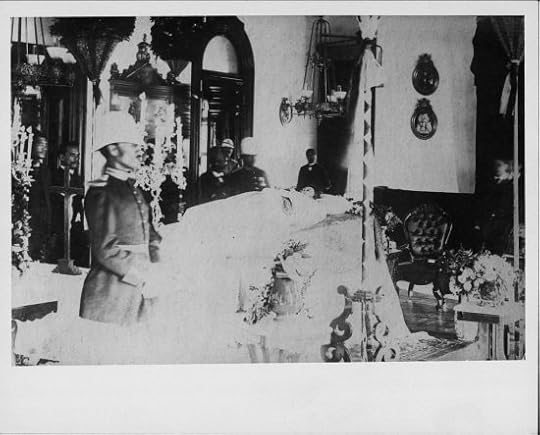 (public domain)
(public domain)Likelike was finally buried on 23 February. At 8.30 A.M the final prayers were read in the throne room, and the funeral began at 1 P.M. Likelike’s coffin was covered with a heavy black pall worked by the sisters of St. Andrew’s Priory, it was lined with white and embroidered with her monogram. The procession to the royal mausoleum took two hours with a gun salute every minute of the way there. Kaiulani and her father followed the coffin in a carriage.
Tragically, Likelike’s prophecy would come to pass. The Hawaiian monarchy was abolished, and Kaiulani never became Queen. She too would die tragically young.
The post Miriam Likelike of Hawaii – Mother of the Crown Princess appeared first on History of Royal Women.



